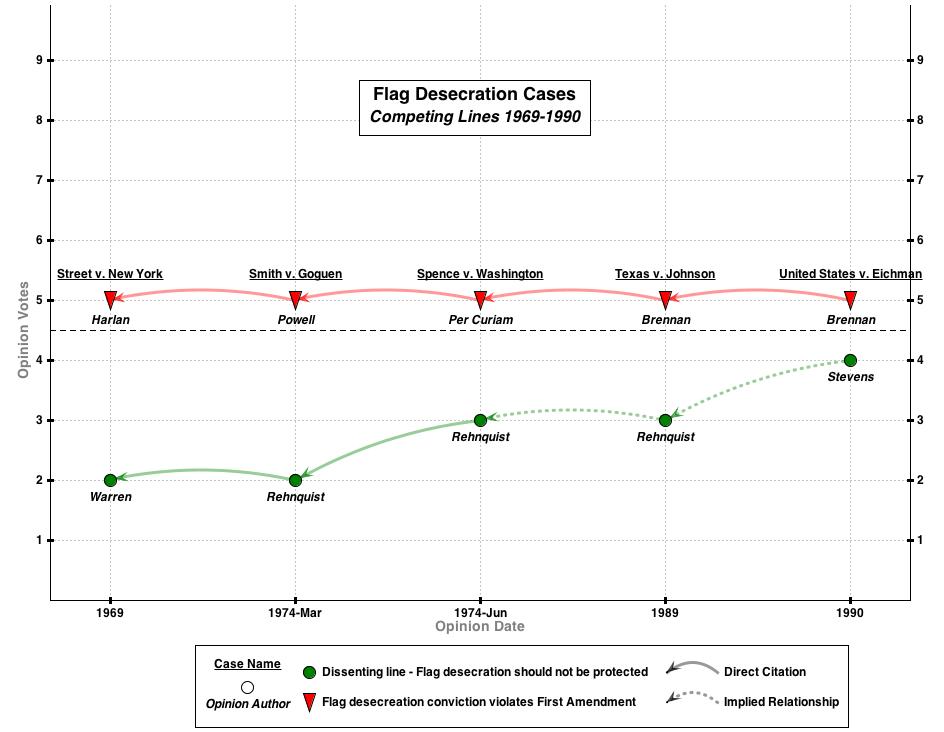Last week, I taught the Flag Desecration Cases in my First Amendment class. It’s an interesting closed citation network since it contains only five cases. (Of course, the First Amendment doctrine implicated by these cases extends widely, but there are only five cases where the Court has directly considered criminal convictions for flag desecration.) This kind of tiny network provides an easy case study to compare the two main types of visualization employed here at the SCOTUS Mapping Project.
 The map above shows all five cases using a Spaeth projection. As I’ve explained before, this projection displays data from the Supreme Court Database (commonly known as Spaeth). Vote for outcome (5-4, 6-3, etc) are displayed on the Y axis as well as outcome type (“liberal” or “conservative” as coded by Spaeth).
The map above shows all five cases using a Spaeth projection. As I’ve explained before, this projection displays data from the Supreme Court Database (commonly known as Spaeth). Vote for outcome (5-4, 6-3, etc) are displayed on the Y axis as well as outcome type (“liberal” or “conservative” as coded by Spaeth).
This network is remarkable in that EVERY case shown is coded liberal by Spaeth. This is because in every flag desecration case that has come before the Court, the conviction has been vacated on First Amendment grounds. At the same time, this result has been consistently controversial. The overall “degree of dissent” in the network is a whopping 0.9 — close to an average 5-4 vote. (Recall a 9-0 case has a 0.0 degree of dissent; a 5-4 has a 1.0 degree of dissent).
Now — compare the map above with this one below, which uses a different projection.
This map shows the exact same territory but uses a standard projection (so-called, because this was the original projection used by the SCOTUS Mapping Project). In this view, the Y axis represents the number of votes an OPINION receives. Thus, every opinion above the dashed middle line is a majority opinion. This projection also gives the name of the author below the case name.
Note how the standard projection presents a slightly different view of what was going on in Goguen and Spence. Both of those cases had 6-3 votes for outcome (as shown in the Spaeth map), but the standard map shows that majority opinions in both cases garnered only five votes. Why? Justice White concurred in judgment only in Goguen while Justice Blackmun concurred in judgment only in Spence. The standard projection better depicts such doctrinal subtleties.
The standard projection also showcases dissents and provides the names of authors of opinions. In this sense, it is richer. However, standard projections cannot — as of now — be generated automatically. Standard maps must be put together by hand using the software. Spaeth projections, on the other hand, can be automatically created by the app. As a means of taking a “first pass” at spotting the competing lines in an area of doctrine, I find Spaeth to be incredibly useful.
Though the standard projections cannot be automatically generated, I have found that integrating Casetext into the process speeds things up. If you click on either map above, you’ll notice that the opinions are in turn linked back to Casetext. As I set about creating the standard projection, I used the Casetext “Quick Facts” features repeatedly to get my data about the individual opinions constituting the map. I then annotated the Casetext cases and linked those annotations back to my map. The result is a fairly robust and self-referential set of dissent-sensitive links.
This mode of linking to user-determined points within an opinion is a first here at “In Progress” and one that strikes me as potentially very useful for folks working with closed networks of Supreme Court doctrine. If any reader is interested in creating such a Casetext Map for their own research or teaching, please let me know.


I appreciate that great effort.